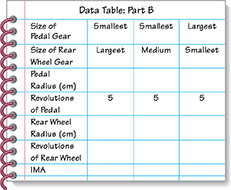Part B: Analyzing Bicycle Gears

On a separate sheet of paper, make a copy of the Data Table for part B.
Measuring Work in groups of three. Use a meter stick to measure the radius of the pedals and the rear wheel as shown. Record these measurements in your data table.
One person should hold the bicycle with its rear wheel slightly off the floor. While a second person turns the pedals, a third person should use the bicycle's gear shifters to place the chain on the smallest pedal gear and the largest rear wheel gear. CAUTION Keep your hands out of the spokes, chain, and gears.
One person should put on a heavy leather glove, while a second person holds the bicycle with its rear wheel slightly off the floor.
The third person should slowly turn the pedals through five complete revolutions. The person who is wearing the glove should gently hold the rear tire tread so that the wheel turns only as fast as the pedals force it to move. This person should also observe the position of the valve stem to count the number of revolutions of the rear wheel. Record the number of revolutions of the rear wheel in your data table.
Repeat Steps 10 through 12, once using the smallest pedal gear and a mid-sized rear-wheel gear, and then again using the largest pedal gear and the smallest rear-wheel gear.
Calculating Use the equation in Step 7 to calculate the mechanical advantage of the bicycle for each gear combination you used. Record these values in your data table.
Analyze and Conclude
Analyzing Data Which combination of pedal and rear wheel gears provided the greatest mechanical advantage? The least advantage?
Applying Concepts To ride quickly on a level road, would you select a gear combination with a large mechanical advantage or a small one? Explain your answer.
Drawing Conclusions To decrease the force needed to ride a bicycle up a steep hill, would you select a gear combination with a large mechanical advantage or a small one? What size rear-wheel gear would you use to race on a flat road? Explain.






